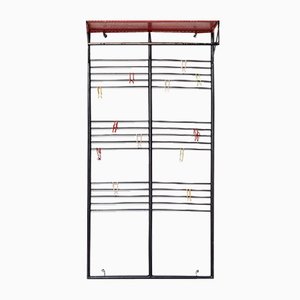
Dutch industrial designer Coen de Vries was born in The Hague in 1918. From 1940 until 1946, he studied interior design at the Royal Academy of Fine Arts in The Hague under Dutch designer Cor Alons (1892-1967). During this time, he also studied on exchange at the Institute of Applied Art (IvKNO) in Amsterdam under visionary architect Mart Stam (1899-1986) and functionalist architect-designer Johan Niegeman (1902-1977). After graduating in 1946, de Vries became a member of the Amsterdam group known as “De 8” from 1947 until 1949. Founded in 1927, De 8 was an architectural avant-garde association that consisted initially of rationalist architects who were educated in the spirit of the Amsterdam School, such as Benjamin Merkelbach (1901-1961), Charles Karsten (1904-1979), and Han Groenewegen (1888-1980).
After graduating, de Vries established his own store named De Sleutel (The Key) in Amsterdam. Here he produced and sold his own designs as well as others, making him the first Dutch interior architects to do so. He produced practical, yet modern furniture at an affordable price in light woods with simple construction and upholstered in brightly colored fabrics.
The philosophy behind De Sleutel was in line with the views propagated by the Stichting Goed Wonen. Like many of his Dutch post-war contemporaries, de Vries was also a member of this Dutch organization. Founded in 1946, the Stichting Goed Wonen (Good Living Association) was a design and industry partnership that was committed to postwar reconstruction and quality-of-life improvements through good design. The group forged many strong collaborations between artists, designers, architects, manufacturers, and customers, which resulted in widespread interest in modernist design principles and aesthetics in the Netherlands. Between 1952 and 1961, de Vries designed five houses for the association in the cities of Weesp (1952-1953), Amsterdam (1956 and 1958-1959), The Hague (1957), and Utrecht (1961). In addition to his work for Goed Wonen, de Vries was often commissioned for the construction of private residential buildings and renovations of interiors.
Over the course of his career de Vries worked as an industrial designer for various manufacturers including Bruynzeel Cabinets, Devo, Eeka Furniture, Everest, Fröscher, Gispen, and Pilastro. De Vries’ work - which spans tables, desks, sofas, and accessories - includes a Model LV1 Coat Rack for Pilastro (1953), a desk in birch with an ebonized x-base for Devo (1954), the Delta Series for Lips (1959), the No. 1451 Chair for Gispen (1967).
Notably, from 1966 to 1972, de Vries was a member of the Council for the Arts, a national advisory board to the Minister of Culture, and from 1977 to 1980 he was a member of the Committee on Architecture of the Amsterdam Arts Council.

